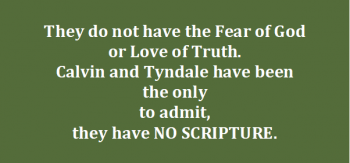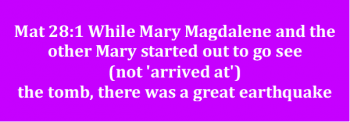- Jan 14, 2014
- 6,303
- 573
- 113
- Faith
- Christian
- Country
- South Africa
A.T. Robertson on Mark 16:2
Quote:When the sun was risen (anateilantos tou h?liou). Genitive absolute, aorist participle, though some manuscripts read anatellontos, present participle. Luke 24:1 has it “at early dawn” (orthrou batheos) and John 20:1 “while it was yet dark.” It was some two miles from Bethany to the tomb. Mark himself gives both notes of time, “very early” (lian pr?i), “when the sun was risen.” Probably they started while it was still dark and the sun was coming up when they arrived at the tomb. All three mention that it was on the first day of the week, our Sunday morning when the women arrive. The body of Jesus was buried late on Friday before the sabbath (our Saturday) which began at sunset. This is made clear as a bell by Luke 23:54 “and the sabbath drew on.” The women rested on the sabbath (Luke 23:56). This visit of the women was in the early morning of our Sunday, the first day of the week. Some people are greatly disturbed over the fact that Jesus did not remain in the grave full seventy-two hours. But he repeatedly said that he would rise on the third day and that is precisely what happened. He was buried on Friday afternoon. He was risen on Sunday morning. If he had really remained in the tomb full three days and then had risen after that, it would have been on the fourth day, not on the third day. The occasional phrase “after three days” is merely a vernacular idiom common in all languages and not meant to be exact and precise like “on the third day.” We can readily understand “after three days” in the sense of “on the third day.” It is impossible to understand “on the third day” to be “on the fourth day.”EndQ
Re:
ATR:
<<It was some two miles from Bethany to the tomb.>>
GE replies:
The two Marys and Salome “after the Sabbath bought spices for when they would go to the tomb they would anoint his body” Mark 16:1, which means the women were in Jerusalem – maybe 400 yards away from the tomb, not <<some two miles from Bethany to the tomb>>.
Re:
ATR:
<<When the sun was risen (anateilantos tou h?liou). Genitive absolute, aorist participle, though some manuscripts read anatellontos, present participle.>>
GE replies:
The sun was not <risen> above the horizon; after midnight it “had been coming up again when very early [lian proh-i] before sunrise” possibly three hours before <the sun was risen> and possibly three hours after “earliest of morning” just after midnight Luke 24:1 [orthrou batheohs], and some 9 hours after John 20:1 “while it was yet early of dark—dusk” [proh-i skotias eti ousehs].
Quote:When the sun was risen (anateilantos tou h?liou). Genitive absolute, aorist participle, though some manuscripts read anatellontos, present participle. Luke 24:1 has it “at early dawn” (orthrou batheos) and John 20:1 “while it was yet dark.” It was some two miles from Bethany to the tomb. Mark himself gives both notes of time, “very early” (lian pr?i), “when the sun was risen.” Probably they started while it was still dark and the sun was coming up when they arrived at the tomb. All three mention that it was on the first day of the week, our Sunday morning when the women arrive. The body of Jesus was buried late on Friday before the sabbath (our Saturday) which began at sunset. This is made clear as a bell by Luke 23:54 “and the sabbath drew on.” The women rested on the sabbath (Luke 23:56). This visit of the women was in the early morning of our Sunday, the first day of the week. Some people are greatly disturbed over the fact that Jesus did not remain in the grave full seventy-two hours. But he repeatedly said that he would rise on the third day and that is precisely what happened. He was buried on Friday afternoon. He was risen on Sunday morning. If he had really remained in the tomb full three days and then had risen after that, it would have been on the fourth day, not on the third day. The occasional phrase “after three days” is merely a vernacular idiom common in all languages and not meant to be exact and precise like “on the third day.” We can readily understand “after three days” in the sense of “on the third day.” It is impossible to understand “on the third day” to be “on the fourth day.”EndQ
Re:
ATR:
<<It was some two miles from Bethany to the tomb.>>
GE replies:
The two Marys and Salome “after the Sabbath bought spices for when they would go to the tomb they would anoint his body” Mark 16:1, which means the women were in Jerusalem – maybe 400 yards away from the tomb, not <<some two miles from Bethany to the tomb>>.
Re:
ATR:
<<When the sun was risen (anateilantos tou h?liou). Genitive absolute, aorist participle, though some manuscripts read anatellontos, present participle.>>
GE replies:
The sun was not <risen> above the horizon; after midnight it “had been coming up again when very early [lian proh-i] before sunrise” possibly three hours before <the sun was risen> and possibly three hours after “earliest of morning” just after midnight Luke 24:1 [orthrou batheohs], and some 9 hours after John 20:1 “while it was yet early of dark—dusk” [proh-i skotias eti ousehs].
Last edited:




